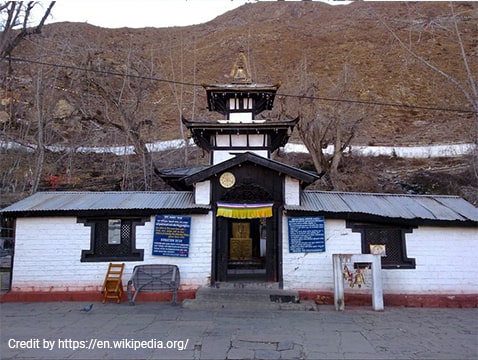Muktinath Temple, Nepal
Click the 'Play' button to read out loud this webpage content
Introduction
Muktinath is a place of worship dedicated to Lord Vishnu. This is one of the Divya Desams, the sacred abodes of Vishnu, which the Azhwar saints have sung about. Incidentally, it is the only Divyadesam on earth that is not situated in our country, but is located in the neighboring country of Nepal, on the banks of the Gandaki River. It lies at the foot of the Thorong La mountain pass in Mustang, Nepal, in the Muktinath valley. The Sanskrit word Mukthi means liberation, and Mukti Nath is the Lord who relieves the human beings of their sins and gives them salvation. Hence Muktinath is hailed as a Mukthi Kshetram, 'the sacred place of salvation' and also a Svayam Vyakta Kshetram, whose deity is self-manifested. This is referred to in ancient times and classical literature as Saligramam. This is also believed to be the place on earth where the forehead of the Goddess Sati fell, and hence the temple is also classified as a 'Shakti Peetam,' the sacred power center of Goddess Shakti. The Shakti here is known as 'Gandaki Chandi,' while the Bhairava aspect of Shiva is called 'Chakrapani.' This temple remains a sacred place not only for Hindus but also for Buddhists. Located at an altitude of 3800 meters in the snow-clad Himalayan mountains, this qualifies for being one of the world's highest temples.
Temple Legends

Saligramam is a naturally formed unique pebble available in large numbers in the river bed of Gandaki. These stones are believed to possess immense spiritual powers, and are regarded as representing Lord Vishnu himself, and are used extensively in Vishnu worship. As these are available in plenty in this region, this place itself was referred to as Saligramam, in olden days.
As per the legends, Lord Vishnu had to play a trick to enable Shiva to destroy the mighty demon Jalandhar. But as a result, he had to incur the curse of Jalandhar's faithful wife. Vishnu thus had to turn into the sacred Saligrama stones, while Vrinda became the Tulsi plant. Lord Vishnu had so much regard for her faithfulness that Tulsi became one of his favorites and used extensively in his worship. And this is true regarding the worship of the Saligrama stones, too.
Muktinath temple is a place of great religious significance, and saints of diverse sects and different faiths have offered prayers in this temple. For instance, Guru Rinpoche, also known as Padmasambhava, the founder of Tibetan Buddhism, meditated in this temple. And Thirumangai Azhwar, the great Vaishnava saint from down South, traveled all the way to the Himalayan mountains in the North many centuries ago and offered prayers to the Lord of Muktinath. It is also believed that Lord Brahma lit an eternal flame that is burning even today in this holy shrine.
Of the total 108 Divyadesams, the chosen temples of Lord Vishnu, 106 are on earth, and Muktinath is said to be the last of these. The other two Divyadesams are said to be in heaven.
The History and Architecture of Muktinath Temple, Nepal
There are references to this temple even in the 10th century CE, and hence, this temple is believed to be quite ancient. The Muktinath temple is of Pakoda type of architecture. The image of the principal deity, Vishnu, as Muktinath, is life-size and is made of gold. The Lord is said to reside here as Sri Paramapatha Nathan, along with his consorts of Bhoomi Dvi, Neela Devi, and Godha Devi. Apart from Vishnu, there are also statues for Lord Shiva and Goddess Parvati here. There are 108 bull faces in the outer courtyard, and water pours out from their mouth. These are regarded as the holy waters from the Pushkarinis, the temple tanks of all the 108 Divyadesams of Vishnu. There are also images of Garuda, Sapta Rishis, and Goddess Saraswati, here. The idols of Andal or Godha Devi and Saint Ramanuja have been installed here and consecrated, in 2009.
Temple Festivals
Apart from daily worship, festivals like Sri Ram Navami, Vijayadasami, and Rishi Tarpani are observed with enthusiasm here, when pilgrims in their thousands visit this place to offer prayers.
Benefits of worshipping Lord Muktinath
Hinduism believes that Maya or illusion is the root cause of all evils. This is the main cause of the eternal cycle of countless births and deaths. It is believed that Lord Muktinath can bestow knowledge and wisdom and help devotees to take the path of righteousness and rise to higher levels of spirituality. He can also restrain people from committing sins and lead them to salvation.
How to reach Muktinath
By Air
The nearest airport is in Jomsom, which offers national and international connectivity by flights. From here, people can travel by road to Ranipauwa and to Muktinath temple. Helicopter services are also available to the temple from Jomsom.
By Rail
The nearest Railway station is Kathmandu, from where people can take buses and private vehicles to the temple.
By Road
Local transport like a private jeep is available from the city of Pokhara to the temple. People are, however, advised to book this in advance.
If you wish to have customized spiritual tours or pilgrimages arranged in India for yourself or for a group of people, please contact Brindavan Mystic Services
Email ID: [email protected]
Toll free: 1800 102 9098